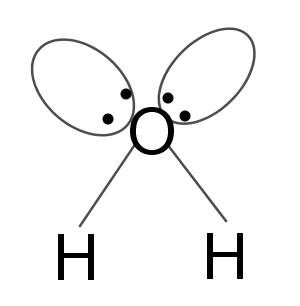
The angular shape of water molecule is due to:
(a).High electron affinity of oxygen
(b).very high repulsion between lone pair and bond pair
(c).very high repulsion between lone pair and lone pair
(d).small size of hydrogen
Answer
502.5k+ views
Hint: Shape of compounds depends on various factors such as availability of different orbitals, no of electron, lone pair, bond pair etc. Valence shell electron pair repulsion theory (VSEPR) helps us to predict the shape of different covalent compounds. It tells us about the repulsion of electrons in the valence shell.
Complete answer:
VSEPR theory gives us the information about lone pairs present in the valence shell, the unpaired electron forms a bond with another unpaired electron and the paired electrons are left as lone pairs. Which causes repulsion between bond pair-bond pair, lone pair-bond pair, lone pair-lone pair and they start arranging themselves to minimize the repulsion. During this process the geometry predicted by hybridization gets distorted and different geometry of molecules are seen.
The shape of the water molecule is angular due to the presence of two lone pairs on the oxygen atom.

And the magnitude of repulsion follows:
\[l.p. - l.p. > l.p. - b.p. > b.p. - b.p.\]
As repulsion among lone pairs is highest the shape of the water molecule becomes V-shaped or angular.
Option (c) is the correct choice.
Option (b) is incorrect as repulsion is seen higher in b.p. then l.p. bond b.p.
Option (d) is incorrect as there is no role of size in the angular shape of the water molecule.
Option (a) is incorrect as electron affinity is the amount of energy released when an electron is added in a neutral atom.
Note:
When we predict the shape of a molecule the bonded pairs of a molecule are considered and not the lone pairs present on that molecule. The geometry of the molecule remains the same which is tetrahedral in case of water. Only the orientation of electron pairs in space changes which changes the shape of the molecule.
Complete answer:
VSEPR theory gives us the information about lone pairs present in the valence shell, the unpaired electron forms a bond with another unpaired electron and the paired electrons are left as lone pairs. Which causes repulsion between bond pair-bond pair, lone pair-bond pair, lone pair-lone pair and they start arranging themselves to minimize the repulsion. During this process the geometry predicted by hybridization gets distorted and different geometry of molecules are seen.
The shape of the water molecule is angular due to the presence of two lone pairs on the oxygen atom.

And the magnitude of repulsion follows:
\[l.p. - l.p. > l.p. - b.p. > b.p. - b.p.\]
As repulsion among lone pairs is highest the shape of the water molecule becomes V-shaped or angular.
Option (c) is the correct choice.
Option (b) is incorrect as repulsion is seen higher in b.p. then l.p. bond b.p.
Option (d) is incorrect as there is no role of size in the angular shape of the water molecule.
Option (a) is incorrect as electron affinity is the amount of energy released when an electron is added in a neutral atom.
Note:
When we predict the shape of a molecule the bonded pairs of a molecule are considered and not the lone pairs present on that molecule. The geometry of the molecule remains the same which is tetrahedral in case of water. Only the orientation of electron pairs in space changes which changes the shape of the molecule.
Recently Updated Pages
Why are manures considered better than fertilizers class 11 biology CBSE

Find the coordinates of the midpoint of the line segment class 11 maths CBSE

Distinguish between static friction limiting friction class 11 physics CBSE

The Chairman of the constituent Assembly was A Jawaharlal class 11 social science CBSE

The first National Commission on Labour NCL submitted class 11 social science CBSE

Number of all subshell of n + l 7 is A 4 B 5 C 6 D class 11 chemistry CBSE

Trending doubts
What is meant by exothermic and endothermic reactions class 11 chemistry CBSE

10 examples of friction in our daily life

One Metric ton is equal to kg A 10000 B 1000 C 100 class 11 physics CBSE

1 Quintal is equal to a 110 kg b 10 kg c 100kg d 1000 class 11 physics CBSE

Difference Between Prokaryotic Cells and Eukaryotic Cells

What are Quantum numbers Explain the quantum number class 11 chemistry CBSE




